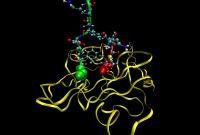
Intein crystal prior to protein splicing. Using powerful computers to model the intricate dance of atoms and molecules, researchers at Rensselaer Polytechnic Institute have revealed the mechanism behind an important biological reaction. In collaboration with scientists from the Wadsworth Center of the New York State Department of Health, the team is working to harness the reaction to develop a "nanoswitch" for a variety of applications, from targeted drug delivery to genomics and proteomics to sensors.
The research is part of a burgeoning discipline called "quantum biology," which taps the skyrocketing power of today's high-performance computers to precisely model complex biological processes. The secret is quantum mechanics -- the much-touted theory from physics that explains the inherent "weirdness" of the atomic realm.
Reporting in the February 2007 issue of Biophysical Journal, the researchers describe a mechanism to explain how an intein -- a type of protein found in single-celled organisms and bacteria -- cuts itself out of the host protein and reconnects the two remaining strands. The intein breaks a protein sequence at two points: first the N-terminal, and then the C-terminal. This aspect of the project, which is led by Saroj Nayak, associate professor of physics, applied physics, and astronomy at Rensselaer, focuses on the C-terminal reaction.
Another Rensselaer team previously found that the reaction at the C-terminal speeds up in acidic environments. But to control the reaction and use it as a nanoswitch, a better understanding of the mechanism behind this reaction is needed, according to Philip Shemella, a doctoral student in physics at Rensselaer and corresponding author of the current paper.
"You can use this protein that cuts itself and joins the pieces together in a predictable way," he said. "It already has a function that would be nice to harness for nanotechnology purposes." And because the reaction may be sensitive to light and other environmental stimuli, the process could become more than just a two-way switch between "on" and "off."
The researchers revealed the details of the reaction mechanism by applying the principles of quantum mechanics -- a mathematical framework that describes the seemingly strange behavior of the smallest known particles. For example, quantum mechanics predicts that an electron can be in two different places at the same time; or that an imaginary cat can be simultaneously dead and alive, as suggested by one famous thought experiment.
Until recently, scientists could not apply quantum mechanics to biological systems because of the large numbers of atoms involved. But the latest generation of supercomputers, along with the development of efficient mathematical tools to solve quantum mechanical equations, is making these calculations possible, according to Shemella.
"Typically, quantum mechanics has been applied to solid-state problems because the symmetry makes the calculation smaller and easier, but there's really nothing different physically between a carbon atom in a protein and a carbon atom in a nanotube," he said. "Even though a protein is such an asymmetric, complex system, when you really zoom into the quantum mechanical level, they are just atoms. It doesn't matter if strange things are happening; it's still just carbon, nitrogen, hydrogen, and oxygen."
Quantum mechanics allows researchers to do things that can't be done with classical physics, such as modeling the way chemical bonds break and form, or including the effect of proton "tunneling" -- allowing protons to move through energy barriers that normal logic would deem impossible.
For this project, the researchers used computing facilities at Rensselaer's Scientific Computation Research Center (SCOREC) and the National Center for Supercomputing Applications at the University of Illinois at Urbana-Champaign. In the future, they hope to take advantage of Rensselaer's new Computational Center for Nanotechnology Innovations -- a $100 million partnership between Rensselaer, IBM, and New York state to create one of the world's most powerful university-based supercomputing centers.
The additional computing power will allow them to model complex biological systems with even greater accuracy: "The more atoms you include, the more accurate your system," Shemella said. Source : Rensselaer Polytechnic Institute
 Print Article
Print Article Mail to a Friend
Mail to a Friend
